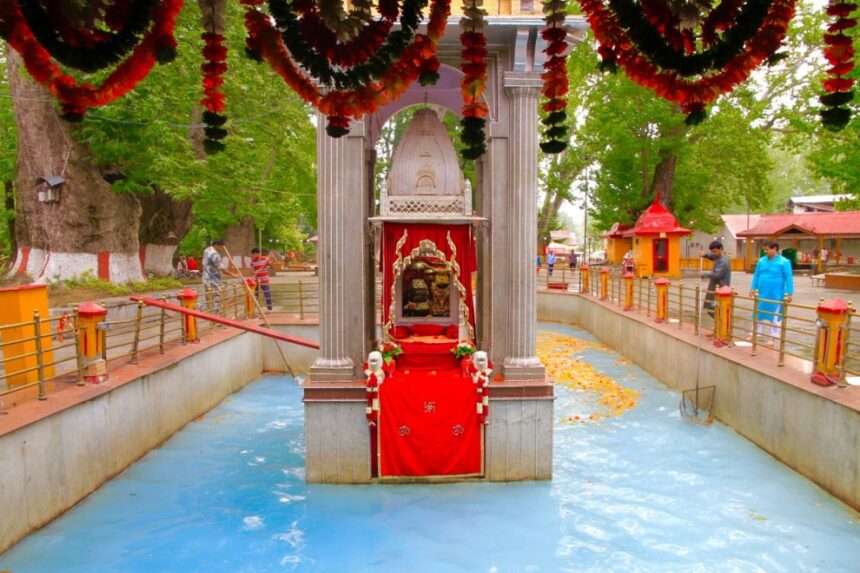In the heart of the verdant Kashmir valley, nestled among the whispering pines and tranquil lakes, lies the ancient village of Tulumula, the sacred abode of Mata Kheer Bhawani. This serene village, cradled by nature, becomes the epicenter of a profound spiritual journey for the Kashmiri Pandits, whose faith and devotion to the goddess transcend time and turmoil. The fast observed on the Shukla Paksha Ashtami of every month is not merely a ritual but a deep-seated testament to their enduring spiritual legacy and communal identity.
The story of Mata Kheer Bhawani begins in the distant land of Lanka, under the reign of the mighty demon king, Ravana. The goddess, known as Mata Maharagina Bhagwati, an incarnation of Durga, was worshiped with fervent devotion by Ravana. His piety and unwavering dedication pleased the goddess, who appeared before him in a blaze of divine light. Ravana, overwhelmed by her divine presence, enshrined her image in Lanka, believing it would bring eternal glory and prosperity to his kingdom.
But as the sands of time flowed, Ravana’s heart succumbed to the shadows of tyranny and hubris. His descent into malevolence tainted the sanctity of his once-noble devotion. The goddess, witnessing the corruption of Ravana’s soul, decided that her divine presence could no longer reside in a land mired in such profound darkness. Her spirit yearned for a place of purity, away from the malevolent influence of the demon king.
The journey of Mata Maharagina from Lanka to Tulumula is a tale of divine orchestration and sacred symbolism. Entrusted in a ‘sani wari’, an earthen pot, the goddess’s image was carried by Hanuman, the revered monkey god of the Ramayana. Hanuman, with his immense strength and unwavering devotion, bore the sacred pot on his shoulders, traversing the vast expanse from Lanka to the serene valley of Kashmir. This act of divine transportation symbolized the transfer of spiritual purity from the land of corruption to a place of untouched sanctity.
Tulumula, surrounded by the villages of Bhavneesh, Tungeesh, Labdavan, and Voker, became the destined abode of the goddess. The sage Bringesh Rishi, in his ancient texts, spoke of this sacred site, echoing its spiritual significance through the annals of time. Kalhana’s Rajatarangini, the ancient chronicle of Kashmir, further immortalized the sanctity of Tulumula, describing the holy spring nestled within its marshy terrain. Devotees, driven by unwavering faith, braved the challenging journey across the marshes, their footsteps guided by the divine call of the goddess.
The legend of Govind Joo, a learned Brahmin, adds a layer of mystical allure to the temple’s history. Govind Joo, blessed with a divine vision, beheld the goddess in the form of a serpent, an embodiment of her protective and nurturing essence. Guided by this vision, he ventured into the marshes with a vessel of milk, a symbol of purity and devotion. As he poured the milk into the sacred spring, the divine presence of Mata Kheer Bhawani manifested, her aura enveloping the surroundings with an ethereal glow. This act of devotion fortified the sacredness of the site, drawing pilgrims from far and wide to seek the blessings of the goddess.
The sanctity of the spring, however, faced a severe test in 1867 when Devan Narsingh Dayal initiated an effort to cleanse the holy waters. Devotees, in their eagerness to participate, overlooked the spiritual purity required for such an endeavor. Some, tainted by the consumption of tamsik meals, disrupted the sacredness of the site, incurring the goddess’s wrath. The ensuing epidemic, a manifestation of divine displeasure, swept through the region, underscoring the importance of maintaining reverence and purity at holy sites.
In a collective act of atonement, the people sought forgiveness from Mata Kheer Bhawani, offering milk and ksheer, a sweet rice pudding, to appease her. Despite their sincere efforts, the epidemic continued to ravage the land, compelling the community to perform a grand hawan on the day of Shukla Paksha Zyeshta Ashtami. The completion of this ritualistic fire ceremony marked the end of the epidemic, signifying the goddess’s forgiveness and reaffirming the spiritual bond between the deity and her devotees.
This pivotal event led to the establishment of enduring traditions that continue to shape the spiritual life of the Kashmiri Pandits. An annual hawan on Shukla Paksha Zyeshta Ashtami was decreed, alongside the observance of a monthly fast on every Shukla Paksha Ashtami. This fast, eschewing tamsik meals and embodying a commitment to spiritual purity, became a cornerstone of Kashmiri Pandit religious practice. It is a day of introspection, prayer, and abstinence, reflecting the community’s unwavering devotion to Mata Kheer Bhawani.
The fast observed on Shukla Paksha Ashtami transcends mere ritual; it is a metaphorical journey into the depths of spiritual consciousness. Each month, as the moon waxes and reaches its eighth day, devotees embark on a path of self-purification, their hearts and minds aligned with the divine essence of the goddess. This practice symbolizes a cyclical renewal of faith, a monthly reaffirmation of their spiritual bond with Mata Kheer Bhawani.
In contemporary times, the Kheer Bhawani temple remains a beacon of spiritual solace and communal unity. The annual festival during Zyeshta Ashtami transforms the temple grounds into a vibrant tapestry of devotion, with thousands of pilgrims gathering to offer their prayers and participate in the hawan. Despite the displacement and challenges faced by the Kashmiri Pandit community due to political turmoil, the tradition of fasting on Shukla Paksha Ashtami endures a testament to their resilience and steadfast faith.
The observance of this fast is not merely a nod to the past but a living embodiment of the community’s spiritual heritage. It serves as a reminder of the goddess’s protective and nurturing presence, reinforcing the importance of purity and devotion in their lives. Through this ritual, the Kashmiri Pandits honor the legacy of their ancestors, preserving the sanctity of their cultural and religious identity in an ever-changing world.
Mata Kheer Bhawani, with her divine grace and boundless compassion, continues to watch over her devotees, her presence felt in the silent whispers of the spring and the serene beauty of the temple. The fast on Shukla Paksha Ashtami is a sacred dialogue between the devotees and their goddess, a monthly communion that transcends the mundane and touches the divine. It is a ritual that binds the past to the present, a timeless expression of faith that illuminates the path of the Kashmiri Pandits, guiding them through the vicissitudes of life with the light of divine grace.
Even today, the Kheer Bhawani temple remains a significant pilgrimage site, drawing devotees from across the globe. The annual festival during Zyeshta Ashtami sees thousands of devotees flocking to the temple to participate in the hawan and offer their prayers. Despite the displacement of many Kashmiri Pandits due to political turmoil, the community continues to uphold the tradition of fasting on Shukla Paksha Ashtami, maintaining their spiritual and cultural heritage.
The observance of fasting on Shukla Paksha Ashtami by Kashmiri Pandits is a testament to their unwavering faith and devotion to Mata Kheer Bhawani. This practice, steeped in historical and mythological significance, serves as a reminder of the goddess’s divine presence and the importance of purity and devotion in spiritual life. Through this ritual, the community continues to honor the legacy of their ancestors, preserving the sanctity of their cultural and religious identity in the face of changing times.
(Author is a columnist and can be reached at: [email protected])








